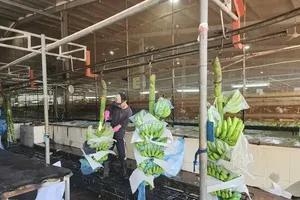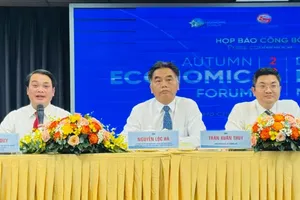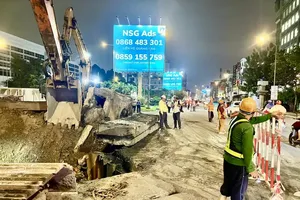
Observations reveal that the An Lac Ward Cultural and Sports Center is showing visible signs of distress. Large cracks have appeared at the base of its walls due to ground subsidence, with some sections sinking nearly as deep as a stairstep. Several structural columns have fractured, with gaps nearing 20cm wide. Not far away, the walls of numerous homes on Le Co Street and Street 2A also display long, running cracks.
N.V.N., a local resident, shared that his family has had to raise their floor and repair cracks multiple times, but the problem recurs every few years. “When I built this house, I knew the ground here was weak, so I reinforced the foundation extra carefully,” he explained. “But up to now, the subsidence and wall cracks just keep happening.”
Subsidence is also plaguing areas in Thanh My Tay Ward. Specifically, in Alley No.67 on Nguyen Huu Canh Street, the foundations of several building walls have cracked and sunk by about 10-20cm.
Bui Thi Le Hoa, a resident of the alley for nearly 50 years, recounted that the area never used to flood. However, in the last four years, the alley has gradually sunk, and now the road floods whenever it rains heavily. “It’s not just the road sinking; every year, more cracks appear on the foundations and walls of many houses,” Ms. Hoa said. “Residents can fix their own cracked houses, but raising the alley road to stop flooding requires direction and support from the local government.”
At the Thanh Da Canal embankment in Thanh My Tay Ward, the situation of erosion and subsidence has reportedly persisted for years without improvement. Previously, in June 2023, local authorities issued an emergency relocation notice for 13 households affected by the canal bank erosion. The notice stated the area had subsided along a length of about 220m, with a width of 2.5m and a depth of 0.5-0.8m, reaching 1m in some spots. It is observed on November 8 that several houses in the affected zone had been shuttered and sealed, with warning signs erected.
Addressing the subsidence in An Lac Ward, Vice Chairman Le Minh Nhut of the An Lac Ward People’s Committee noted that the area was originally formed on weak soil, making subsidence inevitable. While public facilities like hospitals and schools remain safe for use, the ground surface in many places is gradually sinking over time.
To mitigate this, the Ward People’s Committee has introduced technical measures to control the weak soil through pile reinforcement. Simultaneously, they are controlling groundwater extraction and limiting the placement of large structures and high-rise buildings in areas with weak foundations.
Meanwhile, a leader from the Thanh My Tay Ward People’s Committee stated that a project to build a permanent embankment for Thanh Da is being “urgently implemented.” Once completed, it is expected to partially resolve the subsidence and erosion in the area. Regarding Alley No.67 on Nguyen Huu Canh Street, the ward will review the information and consider specific plans to support residents in raising the alley and clearing drains to limit flooding.

Assoc Prof Dr Le Trung Chon notes HCMC sits on weak sediment, but the primary cause of subsidence is excessive groundwater extraction. Rapid urbanization and traffic loads exacerbate this. With over 50 percent of the city just 1-2m above sea level, Dr Chon argues subsidence must be an “indispensable input data point” in master planning. He insists on integrating this data into all urban, rural, and agricultural development projects to manage risks effectively.
Dr. Pham Viet Thuan, meanwhile, urges planning that follows nature to halt subsidence. He advocates building open canals, clearing drainage, and avoiding the concreting of public works to ensure water permeability and prevent waterlogging.
Recently, the HCMC Department of Agriculture and Environment released data on the city’s subsidence situation. Since late 2019, surface subsidence has been continuous, with the largest measured drop being 31mm. The area of rapid subsidence (>15mm/year) covers 14,775ha; relatively rapid subsidence (10-15mm/year) covers 22,331ha; and moderate subsidence (5-10mm/year) covers 29,560ha.
HCMC has reportedly rolled out various tasks and solutions to respond to ground subsidence. These include continuing to monitor ground deformation at two stations in Tan Tao Industrial Park and Binh Hung Commune using differential Synthetic Aperture Radar Interferometry (InSAR) technology; reducing groundwater extraction and filling in wells; and issuing a list and zoning map restricting groundwater extraction.
























